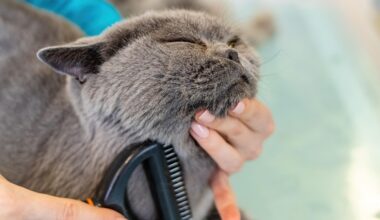Preventing Common Grooming Challenges Through Long-Term Planning
Grooming your cat effectively requires a well-thought-out plan focusing on long-term care. Cats often face various challenges during grooming sessions, including anxiety, matting, and skin irritation. To combat these potential issues, it is essential to develop a consistent schedule, helping your cat become accustomed to frequent grooming. One vital aspect of your long-term grooming plan is incorporating short grooming sessions into your daily routine, which gradually desensitizes your feline friend to the process. Start by familiarizing them with grooming tools such as brushes, clippers, and combs while rewarding positive behavior with treats. Regularly trimming your cat’s nails and brushing their fur will encourage habit formation and alleviate stress over time. Consistency will not only make the grooming process more manageable but will also enhance your cat’s overall comfort and health. Also, keep an eye on seasonal requirements, as different coat lengths require varied grooming frequency. Combine these efforts with veterinary check-ups to monitor your cat’s skin and overall well-being. Before you know it, your cat will view grooming as a rewarding experience rather than a struggle.
To implement long-term grooming plans effectively, it is crucial to establish a grooming routine tailored to your cat’s specific needs. Different breeds may require different grooming techniques and frequency. Long-haired cats often necessitate more ongoing maintenance than short-haired counterparts. Paying special attention to your cat’s breed characteristics can help you tailor your plan effectively. Understanding how frequently your cat should be groomed will minimize the risk of mats and tangles, making the grooming experience smoother, reducing discomfort. Make it goal-oriented by listing the tools necessary, including grooming brushes, shampoos, and nail clippers, to facilitate the process. It might also be beneficial to engage family members in the grooming routines from a young age, helping them understand its importance. Socialization also plays a role, as exposing your cat to grooming at an early age can instill familiarity and comfort in the process, making it easier for all involved. Tracking your cat’s grooming outcomes over time will give you insights, helping you to adjust your plans as needed and ensuring that your cat remains happy and healthy throughout their life.
Understanding Cat Needs for Optimal Grooming
An essential part of long-term grooming plans is understanding the unique needs of your cat. Each cat has its personality, preferences, and tolerances that can significantly influence grooming sessions. Seeking professional grooming help initially can help identify any potential issues your cat may have with their current grooming habits. Additionally, consult with veterinarians to understand any specific health concerns requiring special attention when grooming. Allergies or sensitivities should be well noted and catered for to ensure a positive grooming experience. Providing a calming environment during grooming is key; consider tranquil music and a comfortable space while grooming. Using feline pheromones can also assist in creating a soothing atmosphere to reduce anxiety. Recognize that some cats may require more time to adapt to grooming processes than others, and patience will go a long way in these instances. Regular observation of your cat’s reactions during grooming sessions helps us learn more about their evolving preferences over time. As your cat becomes more comfortable, they may even seek out grooming as a pleasant activity, paving the way for a healthier routine.
Incorporating play into the grooming routine can significantly enhance the experience for both owner and cat. Using toys during grooming sessions can make the process feel less intimidating and more enjoyable for your feline companion. Designate a few minutes before or after grooming to engage them with their favorite toy or perhaps a new gadget intended for play. They can associate grooming with playtime, so you create a positive association that can facilitate a smoother grooming experience overall. Perhaps rewards with a treat or play can distract them during more challenging tasks such as nail trimming or brushing difficult spots. Mapping out a clear schedule combining play and grooming will ensure consistency. This technique will also serve to strengthen your bond with your cat. Reward systems are effective in promoting positive behavior throughout the grooming sessions, showing your pet that this is a valued experience. Over time, your cat may look forward to grooming sessions, resulting in less resistance and reducing the common challenges often associated with grooming. Remember, every little bit counts and the effort you put into this will pay off immensely.
Creating an Adaptable Grooming Strategy
As you execute your long-term grooming plan, maintaining adaptability is crucial. Changes in seasons or your cat’s health may necessitate shifts in your grooming approach. For example, during shedding seasons, increased brushing may be required, especially for long-haired cats. Adjust your strategy based on your cat’s response, observing whether they feel more anxious or apprehensive during specific periods. Sometimes, health changes may dictate increases in grooming frequency, such as if your cat’s coat changes due to weight gain or specific medical conditions. Ensuring your grooming tools are prepared for different situations helps you adapt effectively as needed. Regularly revisiting the grooming plan will ensure you stay aware of what works for your cat and what does not. In tune with these adjustments, consider documenting your grooming efforts and progress to keep track of improvements, noting which strategies yield the best results. Ultimately, creating an adaptable grooming strategy fosters a responsive, efficient long-term grooming plan to meet your cat’s evolving needs holistically.
Maintaining cleanliness and hygiene is paramount in any long-term grooming plan. Ensure all grooming tools are regularly cleaned and that your cat’s grooming area is tidy and inviting. Keeping the brushes, combs, and clippers disinfected will prevent any spread of irritants or infections that can arise from dirty tools. Additionally, keeping your cat’s bathing area well-maintained will always add to comfort during post-grooming cleaning. Implementing regular health checks as part of the routine will ensure that you effectively address any potential problems that might arise during grooming. Checking for any unusual skin conditions, mats, or sores ensures that you efficiently address issues, eliminating them before they escalate. Moreover, improving your cat’s diet can also contribute to better grooming results. Quality nutrition can directly influence fur quality, reducing excess shedding and matting. Sharing knowledge and experiences with fellow cat owners helps create a community approach to grooming, supporting one another in tracking your progress. You are not alone, and gathering insights can lead to creating a more comprehensive grooming plan.
Conclusion: Embracing Long-Term Grooming Success
In conclusion, successful grooming for your cat hinges on effective long-term planning and adaptability tailored to individual needs. Preventing common grooming challenges means setting the stage early on. Your investment of time into observing, engaging, and adjusting your strategies will pay off significantly. Throughout the process, communicating with your cat, understanding their preferences and boundaries, and adapting your approaches as necessary creates a more harmonious experience for both of you. As you implement your grooming plans, remember to celebrate the small victories that come along the journey. Acknowledching improvements contributes to a positive atmosphere, yielding better outcomes. With love, patience, and a consistent approach, over time your cat will learn to embrace grooming as a valued and soothing experience. Continuous education on grooming best practices will empower you to respond to changes effectively, ensuring that your cat remains comfortable and well-groomed. By establishing routines, documenting progress, and creating expectations, grooming can transition from a daunting chore to a rewarding ritual both you and your cat can enjoy together.


